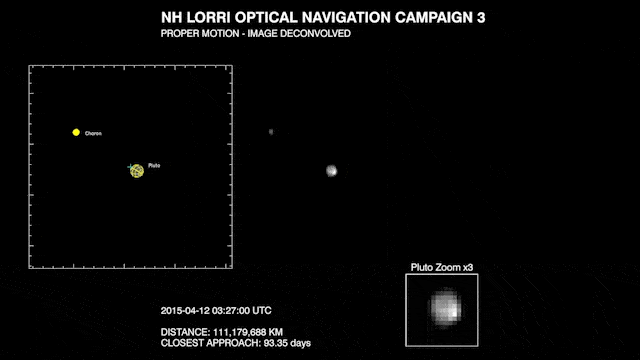The New Horizons spacecraft snapped a picture of Pluto – the best we have so far. NASA released the information and pictures yesterday, along with the theory that Pluto may have a polar cap.
Astronomers were delighted; the time-lapse image, taken between April 12 and April 18, shows us something we’ve never seen before on Pluto: surface details.
“These discoveries are first of a kind,” John M. Grunsfeld, Associate Administrator for the Science Mission Directorate, said in a conference call. “We’re close enough to Pluto to show us features where no Hubble has gone before.”
The images showed that the dwarf planet has not only surface marks, but also a bright area at one of the poles, which may be a polar cap.
“As we approach the Pluto system, we are starting to see intriguing features such as a bright region near Pluto’s visible pole, starting the great scientific adventure to understand this enigmatic celestial object,” explained John Grunsfeld, associate administrator for NASA’s Science Mission Directorate in Washington, DC.
Alan Stern, principal investigator of the New Horizons mission, said this confirms what astronomers suspected about Pluto – so this is confirming assumptions, rather than changing them.
“What they confirm for us is the strong albedo differences across pluto’s surface that were first seen by Hubble 20 years ago,” Stern said.
There’s a lot to be seen on Pluto, a dwarf planet of which we have very limited information, so you can expect the “Best Picture of Pluto” to come up several times in the near future, as New Horizons approaches it more and more. Right now, the spacecraft is at a distance of about 113 million km. At the moment, astronomers believe that Pluto is approximately 70 percent rocky, with a layering of ices above the rocky core, with nitrogen, carbon monoxide, and methane ices at the top. But on the other hand, Charon, its satellite, seems to be composed of ice, so that gives the system an interesting dynamic. Charon was also captured in these images, but the exposure was much to short for Pluto’s other moons to also appear.
So far, everything seems to be going according to plan… or even better. Personally, I can’t really wait for New Horizons to get even closer to Pluto.
“We’re actually pulling out details about a month in advance of where we thought we’d be,” said New Horizons project scientist Hal Weaver of the Johns Hopkins Applied Physics Lab. “By the time we get to the closest approach to Pluto, it’s going to blow us all away.”
For the people working on the mission, it’s a fantastic achievement.
“Seeing it go from a point of light to a place we’re actually investigating made me a little emotional,” Stern says.







